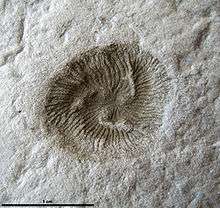Tribrachidium
Tribrachidium heraldicum is a tri-radially symmetrical fossil animal that lived in the late Ediacaran (Vendian) seas. In life, it was hemispherical in form. T. heraldicum is the best known member of the extinct group Trilobozoa.
| Tribrachidium heraldicum | |
|---|---|
 | |
| Fossil of Tribrachidium heraldicum | |
| Scientific classification | |
| Kingdom: | Animalia |
| Phylum: | †Trilobozoa |
| Family: | †Tribrachididae Runnegar, 1992 |
| Genus: | †Tribrachidium Glaessner, 1959 |
| Species: | †T. heraldicum |
| Binomial name | |
| †Tribrachidium heraldicum Glaessner, 1959 | |
Etymology
The generic name Tribrachidium is derived from combination of the Greek τρία (tria, "three") + Latin brachium ("arm") + diminutive suffix -idium. The specific name T. heraldicum references the similarity of the pattern of this fossil with the well-known heraldic triskelion design, such as the coat of arms of the Isle of Man.[1]
Occurrence
Tribrachidium fossils were first discovered in the Ediacara Member of the Rawnslay Quartzite, Flinders Ranges in South Australia.[1][2] This fossil is also known from the Mogilev Formation in the Dniester River Basin, Podolia, Ukraine[3] and from the Verkhovka, Zimnegory and Yorga Formations in the White Sea area of the Arkhangelsk Region, Russia.[4][5]
Description
T. heraldicum is preserved as negative impressions on the base of sandstone beds. These fossils have a circular, three-lobe form, with straight or trefoil-like edges; they are usually covered by numerous radial branched furrows. The central part of the fossil has three hooked ridges ("arms"). The lobes are twisted into weak spirals.[6]
The diameter of specimens ranges from 3 to 50 millimetres (0.3 to 5.0 cm).
Reconstruction and affinity
Tribrachidium was originally described by Martin Glaessner as a problematic organism, one that is excluded from all known major groups of animals by its tri-radial symmetry. However, Tribrachidium's superficial resemblance to edrioasteroid echinoderms was well known to researchers and discussed.[1][2] Later, Glaessner rejected any putative affinities of this animal with any known phyla, leaving the status of its taxonomy uncertain.[7] Originally, the various structures on the poorly preserved Australian specimens were interpreted as tentacles, peculiar arms and mouth,[2] but later this interpretation was rejected. Its mode of locomotion in life also remains unknown.
With the discovery of the closely related Albumares and Anfesta, along with the discoveries of much better-preserved Russian specimens, Mikhail Fedonkin proposed for these animals the new taxon, Trilobozoa – an extinct group of tri-radially symmetrical coelenterate-grade animals.[8][9] Originally, Trilobozoa was erected as a separate class in the phylum Coelenterata, but since Coelenterata was divided into separate phyla Cnidaria and Ctenophora, the Trilobozoa have been transferred to the rank of phylum.[10]
M. Fedonkin has shown that the fossil of Tribrachidium is an imprint of the upper side of the animal's body, with some elements of its external and internal anatomy. The radial furrows on the fossil are radial grooves on the surface of the living animal, while the three hooked ridges in central part of the fossil are imprints of cavities within the body.[8] Tribrachidium was a soft-bodied benthic organism that temporarily attached (but did not accrete) to the substrate of its habitat (microbial mats).[6]
See also
- Albumares brunsae
- Anfesta stankovskii
- List of Ediacaran genera
References
- Glaessner, M.F.; Daily, B. (1959). "The geology and Late Precambrian fauna of the Ediacara fossil reserve" (PDF). Records of the South Australian Museum. 13 (3): 369–401.
- Glaessner, M.F.; Wade, M. (1966). "The late Precambrian fossils from Ediacara, South Australia" (PDF). Palaeontology. 9 (4): 599.
- Fedonkin, M. A. (1983). "Non-skeletal fauna of Podoloia, Dniester River valley". In Velikanov, V. A.; Asse]eva, E. A.; Fedonkin, M. A. (eds.). The Vendian of the Ukraine (in Russian). Kiev: Naukova Dumka. pp. 128–139.
- Fedonkin M.A. (1978). "New locality of non-skeletal Metazoa in the Vendian of Whinter Coast". Doklady Akademii Nauk SSSR (in Russian). 239 (6): 1423–1426.
- Fedonkin M. A.; Gehling J. G.; Grey K.; Narbonne G. M. & Vickers-Rich P. (2007). The Rise of Animals. Evolution and Diversification of the Kingdom Animalia. Johns Hopkins University Press. p. 326. ISBN 978-0-8018-8679-9.
- Ivantsov, A. Yu.; Leonov M. V. (2009). The imprints of Vendian animals - unique paleontological objects of the Arkhangelsk region (in Russian). Arkhangelsk. p. 16. ISBN 978-5-903625-04-8.
- Glaessner, M. F. (1979). "Precambrian". In Robison, R. A.; Teichen, C. (eds.). Treatise on invertebrate paleontology, Part A. Boulder, Colorado, Geological Society of America: University of Kansas Press. pp. 79–118.
- Fedonkin, M. A. (1985). "Systematic Description of Vendian Metazoa". In Sokolov, B. S.; Iwanowski, A. B. (eds.). Vendian System: Historical–Geological and Paleontological Foundation, Vol. 1: Paleontology (in Russian). Moscow: Nauka. pp. 70–106.
- Fedonkin, M. A. (1990). "Precambrian Metazoans". In Briggs D.; Crowther P. (eds.). Palaeobiology: A Synthesis (PDF). Blackwell. pp. 17–24. Archived from the original (PDF) on 2012-01-12. Retrieved 2013-03-24.
- Runnegar, B. N.; Fedonkin, M. A (1992). "Proterozoic Metazoan Body Fossils". In Schopf, J. W.; Klein, C. (eds.). The Proterozoic Biosphere: A Multidisciplinary Study. Cambridge University Press. p. 373.
External links
- Palaeos dendrogram
- Ediacara Assemblage University of Bristol
- Anatomical Information Content in the Ediacaran Fossils and Their Possible Zoological Affinities, Jerry Dzik, Instytut Paleobiologii PAN, Twarda 51/55, 00-818 Warszawa, Poland